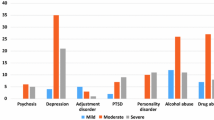Abstract
Forensic psychiatric patients consume an increasing proportion of mental health resources in Canada and the United States. To inform mental health policy and practice, we compared the criminogenic, clinical, and social problems of forensic patients to those of civilly committed psychiatric patients in two Canadian studies. We predicted that forensic patients would score higher on criminogenic problems and lower on clinical and socialproblems than civil patients in two studies: one comparing 83 forensic and 189 civil inpatients on a clinician-completed form, the Resident Assessment Instrument—Mental Health, at an urban mental health center, and the second comparing 423 forensic and 178 civil patients assessed at different times using the Patient Problem Survey. The two studies were quite similar in their findings, despite differences in their samples, measures, anddata collection methods. In both studies, forensic patients were similar to or lower than civil psychiatric patients in all criminogenic, clinical, and social problems. We conclude that forensic mental health services would benefit greatly by drawing from knowledge accumulated in the general psychiatric literature. This finding also supports the idea that many forensic patients can be appropriately diverted to nonforensic mental health services.
Similar content being viewed by others
REFERENCES
Bonta, J., Law, M., & Hanson, K. (1998). The prediction of criminal and violent recidivism among mentally disordered offenders: A meta-analysis. Psychological Bulletin, 123, 123–142.
Harris, G. T., Hilton, N. Z., & Rice, M. E. (1993). Patients admitted to psychiatric hospital: Presenting problems and resolution at discharge. Canadian Journal of Behavioural Science, 25, 267–285.
Harris, G. T., & Rice, M. E. (1990). An empirical approach to classification and treatment planning for psychiatric inpatients. Journal of Clinical Psychology, 46, 3–15.
Harris, G. T., Rice, M. E., & Camilleri, J. A. (2004). Applying a forensic actuarial assessment (the Violence Risk Appraisal Guide) to nonforensic patients. Journal of Interpersonal Violence, 19, 1063–1074.
Heilbrun, K., Golloway, G. G., Shoukry, V. E., & Gustafson, D. (1995). Physical control of patients on an inpatient setting: Forensic vs. civil populations. Psychiatric Quarterly, 66, 133–145.
Hilton, N. Z., & Simmons, J. L. (2001). The influence of actuarial risk assessment in clinical judgments and tribunal decisions about mentally disordered offenders in maximum security. Law and Human Behavior, 25, 391–406.
Hirdes, J. P., Smith, T. F., Rabinowitz, T., Yamauchi, K., Perez, E., Telegdi, N. C., et al. on behalf of the RAI-MH Group. (2002). Resident Assessment Instrument-Mental Health (RAI-MH): inter-rater reliability and convergent validity. Journal of Behavioral Health Services and Research, 29, 419–432.
Monahan, J., Steadman, H. J., Silver, E., Appelbaum, P. S., Robbins, P. C., Mulvey, E. P., et al. (2001). Rethinking risk assessment: The MacArthur study of mental disorder and violence. New York: Oxford University Press.
Moskowitz, J. L., Lewis, R. J., Ito, M. S., & Ehrmentraut, J. (1999). MMPI-2 profiles of NGRI and civil patients and civil patients. Journal of Clinical Psychology, 55, 659–668.
Quinsey, V. L., Coleman, G., Jones, B., & Altrows, I. F. (1997). Proximal antecedents of eloping and reoffending among supervised mentally disordered offenders. Journal of Interpersonal Violence, 12, 794–813.
Quinsey, V. L., Cyr, M., & Lavallee, Y. J. (1988). Treatment opportunities in a maximum security psychiatric hospital: A problem survey. International Journal of Law and Psychiatry, 11, 179–194.
Rice, M. E., & Harris, G. T. (1988). An empirical approach to the classification and treatment of maximum security psychiatric patients. Behavioral Sciences and the Law, 6, 497–514.
Rice, M. E., Harris, G. T., Cormier, C. A., Lang, C., Coleman, G., & Smith Krans, T. (in press). Anempirical approach to planning and evaluating services for forensic patients. Issues in Forensic Psychology. British Psychological Society.
Rice, M. E., Harris, G. T., & Quinsey, V. L. (1996). Treatment for forensic patients. In B. D. Sales & S. A. Shah (Eds.), Mental health and law: Research, policy and service (pp. 141–189). New York: Carolina Academic.
Schneider, R. D. (2000, April 7). Statistical survey of provincial and territorial review boards. Report prepared for Federal Department of Justice.
Schulz, D. E. (1995). Acomparison of thought disorder, premorbid adjustment, and psychopathy between forensic and civil psychiatric inpatients. Dissertation Abstracts International: Section B: The Sciences and Engineering, 56(11), 6406. (UMI No. 9608023).
Seto, M. C., Lalumi` ere, M. L., Harris, G. T., Barbaree, H. E., Hilton, N. Z., Rice, M. E., et al. (2001). Demands on forensic mental health services in the province of Ontario. Report prepared for the Ontario Ministry of Health and Long-Term Care.
Author information
Authors and Affiliations
About this article
Cite this article
Seto, M.C., Harris, G.T. & Rice, M.E. The Criminogenic, Clinical, and Social Problems of Forensic and Civil Psychiatric Patients. Law Hum Behav 28, 577–586 (2004). https://doi.org/10.1023/B:LAHU.0000046435.98590.55
Issue Date:
DOI: https://doi.org/10.1023/B:LAHU.0000046435.98590.55




